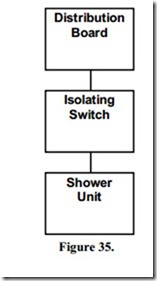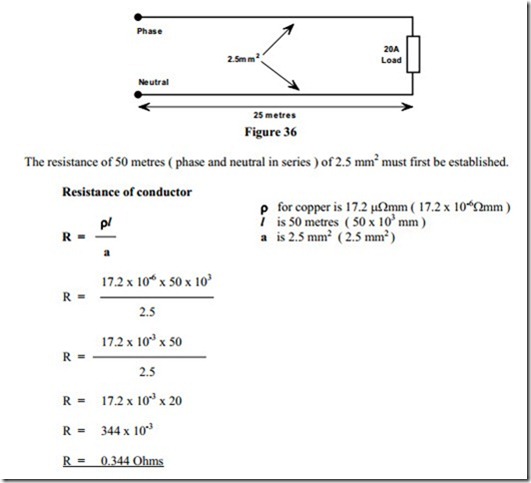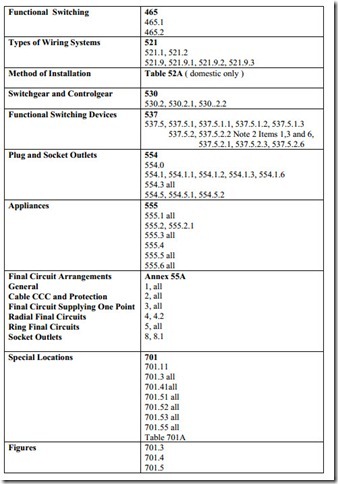Electrical Equipment in a Shower or Bathroom
There is an increased risk of electric shock in showers and bathrooms. This is due to the reduction in body resistance ( skin wet ) and the possibility of contact with earth potential. Items of electrical equipment installed in a shower or bathroom are treated as being within carefully defined zones.
The plan and side elevation of these zones are shown in the ETCI Rules. There are four zones ( bear in mind that zone 0 is the first of the four zones):
1. Zone 0
2. Zone 1
3. Zone 2
4. Zone 3
In order that these zones are understood it is of great assistance if different coloured high- lighters are used to define the boundaries of each zone as shown in the ETCI Rules.
The items of electrical equipment which may be safely installed in each of the four zones are specified in the ETCI rules.
Instantaneous Electric Showers
An electric shower heats only the required amount of water, instantaneously. Energy is saved as hot water does not have to be stored. Taking a shower uses a lot less water than taking a bath. Electric showers are rated in kW’s. The higher the wattage, the better the performance of the shower. They are available in the following power ratings:-
7.5 kW, 8.0 kW, 8.5 kW, 9.0 kW, 9.5 kW, 10.0 kW and 10.5 kW.
Installation
Before installation commences it will be necessary for the electrician to assess several factors.
· The Power Rating, in order to decide on cable size. The following sizes of cables and equipment will normally be adequate.
· The Location, in order to estimate the length of cable run. The cable run must be measured from the distribution board to the shower location, allowing for isolating switch ( usually located on the ceiling close to the shower ).
· The Earthing Arrangements, to ensure safe operation of the shower and protect against electric shock. Earthing and bonding must comply with ETCI Rules for locations containing a bath or shower.
· Cable and Personal Protection, to protect against overload, short circuit and earth fault.
The circuit must include a 30 mA RCD, a 40 A FUSE / MCB and a 40 A / 45 A isolating switch. An RCBO may be used rather than a separate RCD and MCB.
· The CSA of the main supply cables, particularly if the shower is an alteration to an existing installation. This is to make sure they are adequate for the load. In some installations the DSO supply cables may not be adequate for the proposed load and it may be necessary to have them upgraded.
Isolation and Switching
An instantaneous electric shower must be fed via a separate radial circuit. This circuit must have a means of isolation and a means of interrupting the full load current of the unit.
It is recommended that this be achieved by a ceiling mounted pull-cord switch located near the shower, or a wall mounted switch outside the bathroom door. In either case it must be under the control of any person ( electrician or plumber ) who may have reason to open the unit for repair.
The switch should be a Double Pole type having contact separation of at least 3 mm when in the “OFF” position. Additionally, it must have reliable indication when the separating distance has been achieved. This latter requirement implies a mechanical indicator ( flag ) rather than a neon lamp, which cannot indicate the degree of separation.
All electrical controls must be inaccessible to a person using the shower with the exception of the following:
· Insulating cords of cord operated switches
· Controls of a suitable shower unit See Figure 35
When selecting a cable for a given load, it is necessary to ensure that it will carry the required current without overheating. Also, the voltage drop between the supply position and the terminals of the load, should not exceed 4% of the nominal supply voltage.
The cable conductor has a certain value of resistance which depends on the following:
· Conductor material ( resistivity )
· Conductor length
· Conductor size ( cross sectional area )
the resistance of 100 metres of 2.5 mm2 copper conductor is approximately 0.7 Ohms.
If the conductor length is increased its resistance will increase and vice-versa. In other words, conductor resistance is directly proportional to conductor length. If the conductor size ( CSA ) is increased its resistance will decrease and vice-versa. In other words, conductor resistance is inversely proportional to its size ( CSA ).
The latter is the main reason for the variety of conductor sizes in use.
There are other factors involved in the selection of cables and these will be covered in Module 2.3.4.
Voltage Drop across Cables
As every cable conductor has resistance ( however low ), there will be a voltage drop across them due to the current flowing through their resistance. If this voltage drop is excessive, the “potential difference” across the load will be low and inefficient operation may be the result.
Since any voltage drop can be expressed as the product of current and resistance ( U = I x R ), voltage drop across a cable depends on the resistance of the conductor and the value of current flowing through it.
· Voltage drop is directly proportional to conductor length
· Voltage drop is directly proportional to the current flowing through the conductor
The voltage drop across a cable supplying a given load, can only be reduced by replacing it with a cable having a larger cross sectional area. This is the main reason for using different sizes of cables e.g.
· 1.5 mm2 for lighting loads
· 2.5 mm2 for heating loads
· 6 mm2 for cooking loads
According to the ETCI Rules the maximum permissable voltage drop allowed is 4% of the nominal supply voltage e.g. 4% of 230 Volts is 9.2 Volts.
This means that the voltage at the terminals of the load should be, not less than 230 Volts minus
9.2 Volts which equals 220.8 Volts.
The following is an example of a basic voltage drop calculation:
Refer to Figure 36. Assume a load of 20 Amps is to be supplied at a distance of 25 metres using
This figure is less than the maximum of 9.2 Volts and so the cable is suitable for the load.
The ETCI Rules provide figures to aid the above calculation and also take into account other factors, which affect the current carrying capacity of cables. These figures are also more accurate as they take into account cable reactance as well as resistance.
Power Dissipated by Cables
Current flowing through a resistor produces heat. This heat must be dissipated by the resistor. Because of conductor resistance, heat is also produced in cables. This heat will have an effect on the cable insulation, and if excessive will result in damage to the cable.
Power is a product of current squared and resistance.




